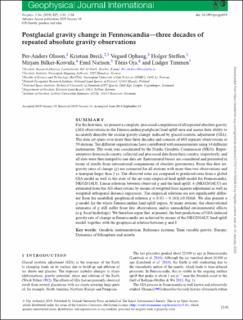| dc.description.abstract | For the first time, we present a complete, processed compilation of all repeated absolute gravity (AG) observations in the Fennoscandian postglacial land uplift area and assess their ability to accurately describe the secular gravity change, induced by glacial isostatic adjustment (GIA). The data set spans over more than three decades and consists of 688 separate observations at 59 stations. Ten different organizations have contributed with measurements using 14 different instruments. The work was coordinated by the Nordic Geodetic Commission (NKG). Representatives from each country collected and processed data from their country, respectively, and all data were then merged to one data set. Instrumental biases are considered and presented in terms of results from international comparisons of absolute gravimeters. From this data set, gravity rates of change (g˙) are estimated for all stations with more than two observations and a timespan larger than 2 yr. The observed rates are compared to predicted rates from a global GIA model as well as the state of the art semi-empirical land uplift model for Fennoscandia, NKG2016LU. Linear relations between observed g˙ and the land uplift, h˙ (NKG2016LU) are estimated from the AG observations by means of weighted least squares adjustment as well as weighted orthogonal distance regression. The empirical relations are not significantly different from the modelled, geophysical relation g˙=0.03−0.163(±0.016)h˙. We also present a g˙-model for the whole Fennoscandian land uplift region. At many stations, the observational estimates of g˙ still suffer from few observations and/or unmodelled environmental effects (e.g. local hydrology). We therefore argue that, at present, the best predictions of GIA-induced gravity rate of change in Fennoscandia are achieved by means of the NKG2016LU land uplift model, together with the geophysical relation between g˙ and h˙. | en_US |

